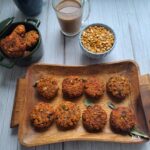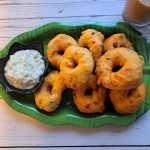Unniyappam

Unniyappam is a traditional snack from the southern Indian state of Kerala, cherished for its unique blend of flavours and textures. These small, round fritters are made from a batter of rice, jaggery, ripe bananas, and grated coconut, then deep-fried to a perfect golden brown. The result is a sweet, aromatic treat with a soft, spongy interior and a lightly crispy exterior. Unniyappam holds a special place in Kerala’s culinary heritage, often prepared during festivals and special occasions, but also enjoyed as a delightful everyday snack. With each bite, unniyappam offers a nostalgic taste of Kerala’s rich food traditions, making it a favourite among both locals and visitors alike.
Making unniyappam using raw rice instead of rice flour can give the snack a more authentic and traditional texture and flavour.
Palayamkottai Banana:
For making unniyappam, the local banana variety commonly used in Kerala and Tamilnadu is the Palayamkottai or Palayamthodan banana. This variety is widely available in Kerala and is preferred for its ideal texture and sweetness, which contribute significantly to the taste and consistency of unniyappam.
Texture and Flavour:
Palayamkottai bananas have a firm yet creamy texture and a natural sweetness that intensifies as they ripen. This makes them perfect for blending into the batter and ensuring that the unniyappam has a balanced sweetness and a soft, moist interior.
Ripeness:
For the best results, the bananas should be fully ripe, characterized by a yellow skin with occasional brown spots. Fully ripe Palayamkottai bananas are easier to mash and incorporate into the batter, ensuring an even distribution of flavour.
Aroma:
This banana variety also has a pleasant, mildly aromatic flavour that complements the other ingredients in unniyappam, such as jaggery, coconut, and cardamom.
Using Palayamkottai bananas in unniyappam is a traditional practice that ensures the snack maintains its authentic taste and texture. The bananas’ natural sweetness helps reduce the need for additional sweeteners, while their creamy texture contributes to the fritters’ moist and spongy interior. This local variety is an essential ingredient in making unniyappam a beloved treat in Kerala households.
You can also use other banana varieties to yield delicious results but to achieve the most authentic taste and texture, Palayamkottai bananas remain the best choice. Each alternative variety brings its own unique flavour profile to the dish.




Unniyappam
Ingredients
1 cup = 250ml
- 1 cup raw rice 250gms
- 175 – 180 gms of jaggery
- 1 ripe banana, preferably palayamkottai banana variety
- 3 tbsp grated coconut
- ¼ teaspoon cardamom powder
- ¼ tsp dry ginger powder
- 1 tsp black sesame seeds optional
- ¼ teaspoon baking soda optional, for a softer texture
- Water as needed
- Ghee or oil for frying
Instructions
Jaggery preparation
- Grate the jaggery or break it into small pieces. Smaller pieces melt more quickly and evenly.
- In a saucepan, add the grated or broken jaggery pieces.
- Pour in about 25ml of water and place the saucepan over medium heat.
- Stir the mixture continuously as the jaggery melts. This helps to dissolve the jaggery evenly and prevents it from sticking to the bottom of the pan.
- Continue cooking until all the jaggery has melted and you have a smooth, thick syrup.
- Once the jaggery has completely melted, you may notice some impurities or undissolved particles.
- Remove the saucepan from heat and strain the syrup through a fine-mesh strainer or cheesecloth into a clean bowl to remove any impurities.
- Let the jaggery syrup cool to room temperature before using it in your recipe.
- This method ensures you have a smooth and impurity-free liquid jaggery, which can be easily incorporated into various dishes.
Batter preparation
- Rinse the raw rice thoroughly in water.
- Soak the rice in enough water for at least 4-5 hours or overnight.
- Drain the soaked rice and grind it to a coarse paste using a blender or a wet grinder. Add the cooled jaggery syrup gradually as needed to achieve a coarse consistency.
- Add the ripe banana, cardamom powder, dry ginger powder, pinch of salt and incorporate them into the batter.
- Add the grated coconut and black sesame seeds (if using) to the batter. Mix thoroughly.
- If using baking soda, add it to the batter and mix well.
- The batter should have a thick, pouring consistency. If it’s too thick, you can add a little water to adjust the consistency.
- Heat 2 tbsp of ghee in a pan, add the coconut slices and roast until golden brown. Add the roasted coconut slices to the batter and mix well.
- Let the batter rest for at least 1 hour to allow the ingredients to blend well and to slightly thicken the batter due to the rice absorbing some moisture.
Frying
- Heat ghee or oil in an appe pan (a special pan with cavities used for frying unniyappam) or a deep frying pan.
- Once the oil is hot, drop spoonfuls of batter into each cavity of the appe pan or into the hot oil if using a deep frying pan.
- Fry the unniyappam on medium heat until they are golden brown and cooked through. Flip them occasionally to ensure even cooking.
- Once done, remove the unniyappam from the oil and drain them on paper towels to remove excess oil.
- Serve the unniyappam warm as a snack or as part of a traditional Kerala meal.
- Enjoy your homemade unniyappam made with raw rice!
Notes
- Both whole and powdered jaggery can be used in this recipe. However, both should be melted down into syrup.
- Adjust the jaggery quantity to suit your personal sweetness preference. The amount given in this recipe is typically a balanced measure, but it’s always good to tweak it if you prefer it sweeter or less sweet.

1 thought on “Unniyappam”